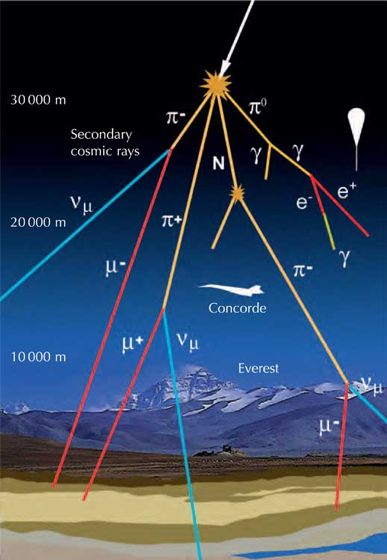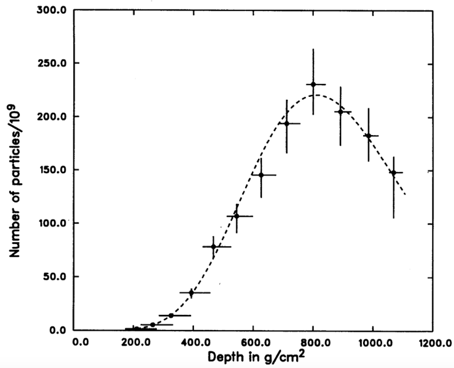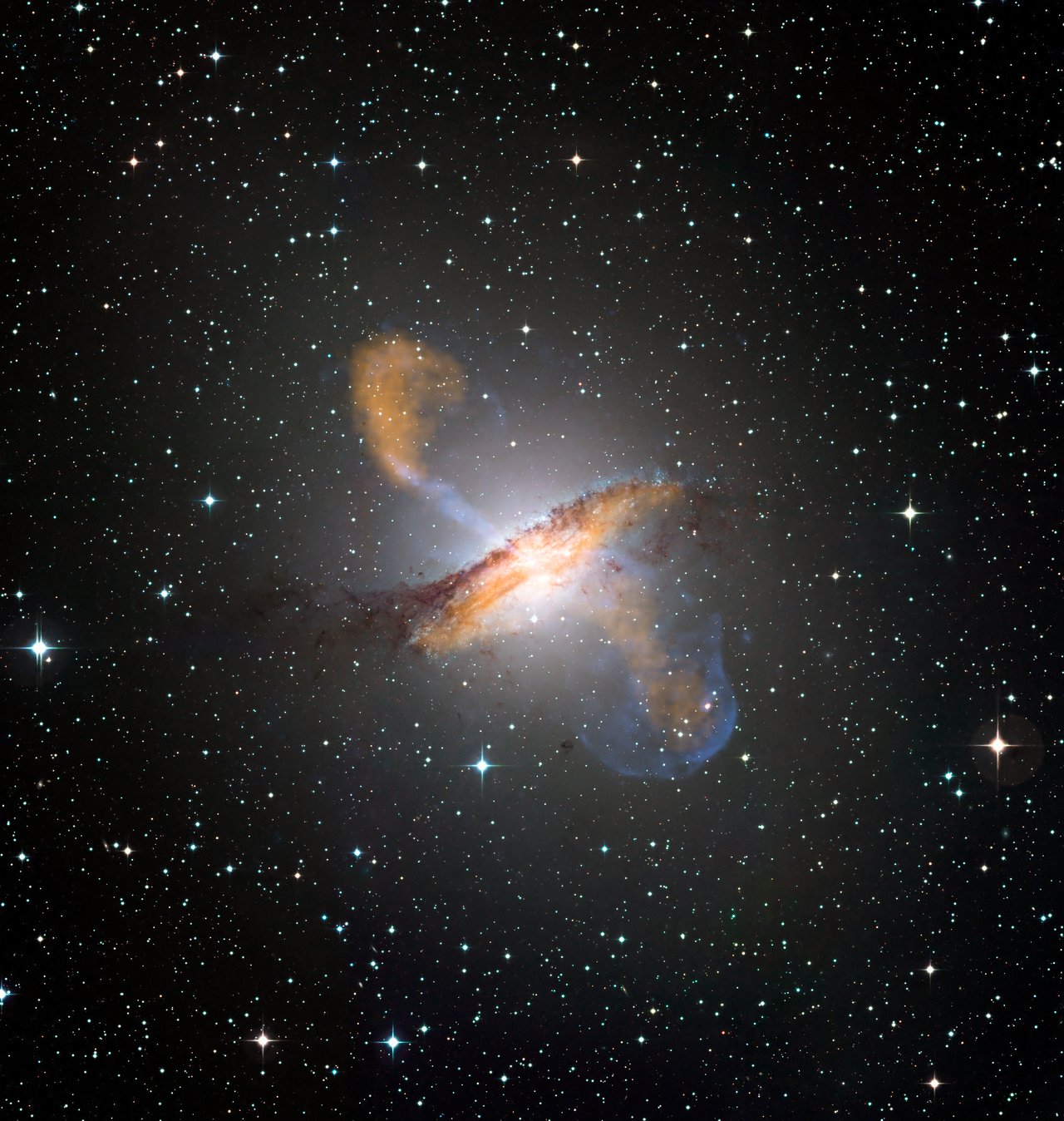The Oh-My-God Particle
By Abhinav Jindal, June 19, 2019
Article: “Detection of a cosmic ray with measured energy well beyond the expected spectral cutoff due to cosmic microwave radiation”
Authors: D. J. Bird et al.
Reference: https://arxiv.org/abs/astro-ph/9410067 [astro-ph]
On October 15, 1991, a particle entered the atmosphere of Earth that stunned the astrophysics community. This particle was subatomic and yet had the same kinetic energy as a 60 mph baseball pitch, ensuring its position as the highest energy cosmic ray observed to date. Today we will be discussing the historic paper that presented this observation.
Ultra-high-energy cosmic rays

Figure 1: A schematic of how a cosmic ray might decay upon reaching the Earth’s atmosphere into a particle shower. Image prepared by Alberto
Izquierdo; courtesy of Francisco
Barradas Solas
Cosmic rays are particles that enter the atmosphere of the Earth from outer space. They are highly energetic atomic nuclei (usually singular protons) which collide with particles in our atmosphere to produce secondary rays that further collide into a myriad type of particles (see Figure 1, and see Max’s article on air showers here). Cosmic rays are fairly common (roughly 200 particles per square meter every second) and are considered to be a nuisance to observational astronomers whose telescopes pick up unwanted rays. However, they come in a variety of energies, and the most energetic types of rays are much rarer.
Ultra-high-energy cosmic rays (UHECRs) are defined as particles with energies that surpass 1018 eV in energy. Particles with an energy of more than 50 times this value are considered extreme-energy cosmic rays (EECRs) because they surpass the Greisen–Zatsepin–Kuzmin (GZK) limit of 8 joules of energy, which is the threshold that the authors refer to in their paper’s title. This threshold is the theoretical upper limit of energy for extragalactic cosmic rays since at such high energies, the cosmic microwave background (CMB) is blueshifted enough to interact with and disrupt the rays. The oh-my-god particle was the first unambiguous EECR ever discovered, possessing an unsurpassed energy of 51 joules (a rare unit to use in particle physics) and challenging this theoretical upper limit. Based on calculations of the probability of interacting with CMB photons, the authors reason that the source of this particular particle must be closer than ~30 Mpc, a distance encompassing thousands of galaxies.
Detecting high energy cosmic rays

Figure 2: One of 67 mirror units within the original Fly’s Eye array. The mirror is 1.5 m in diameter and a cluster of 14 photomultiplier tubes are mounted in the focal plane. Source: Baltrusaitis et al. (1985)
The detection of the oh-my-god particle in 1991 was made at the original Fly’s Eye telescope array in Utah, located at the top of Little Granite Mountain at an elevation of over 5000 feet. The array consists of 67 spherical section mirrors, each with 12 or 14 hexagonally packed light collectors and photomultiplier tubes (“eyes”) mounted at the focal plane (see Figure 2). Between all the mirrors, the array was able to observe the whole overhead sky, a feat that had not been accomplished by cosmic ray detectors at the time. A second, smaller array (Fly’s Eye II) was located 3.3 km away to help with the localization of showers. The Fly’s Eye was designed to be effective at an ultraviolet wavelength range of approximately 230 – 500 nm. This is an optimal range for observing cosmic rays due to the nature of the light emitted by interactions with atmospheric particles.

Figure 3: Fluorescence spectrum due mostly to the 2P band of N2 and 1N band of N2+. Source: Baltrusaitis et al. (1985)
A combination of four different effects generate the light from cosmic rays that is ultimately observed by detectors such as the Fly’s Eye. The first is atmospheric fluorescence. Most of the kinetic energy of a cosmic ray is used to excite electrons of molecular nitrogen in the air through collisions, which then emit light as the electrons fall back down into lower energy orbitals (see Figure 3 for the spectrum). The intensity of this light is directly proportional to the number of charged particles, and thus serves as a useful probe to reconstructing a particle shower. The second is Cherenkov radiation, which is light emitted as a result of the charged particles moving faster than the phase speed of light in air. This light adds noise to the data and makes it more difficult for observers to determine the size of the shower. The third is Rayleigh scattering, which is the elastic (no change in wavelength) scattering of light in all directions by particles smaller than the wavelength of the light. The fourth is Mie scattering, which is similar to Rayleigh scattering but the scattering occurs predominantly in the same direction as the incident radiation and is due to particles that are similar in size or larger than the wavelength of the light. The latter two effects are not sources of light, but they still affect the signal detected by the Fly’s Eye.
Measuring the oh-my-god particle
Whenever the detector observes a shower of fluorescent light move across the sky, the orientation of the streak and the incident energy can be measured. The stereoscopic location of the streak is restricted to a plane that passes through the line observed on the sky and the telescope itself, and the distance is not directly available. However, the Fly’s Eye makes use of its two arrays separated by 3.3 km to obtain two different planes, and the intersection of these planes determines the complete location of the shower. Unfortunately, the oh-my-god particle was in the blind spot of Fly’s Eye II, so an exact stereoscopic location could not be determined. The authors reason that the streak probably moves at very nearly the speed of light and, given the measured angular speed, calculate a perpendicular distance to the axis of the shower as roughly 13 km from the Fly’s Eye. It is possible that the streak was caused by something like a meteorite that was much closer to the detector and moving more slowly. However, the authors reason that since meteorites usually enter the atmosphere at a thousandth the speed of light, it would have to be within 100 m of the telescope and would therefore result in parallax between the different mirrors of the Fly’s Eye, which was not observed. The cosmic ray scenario is indeed favored. The authors also rule out velocities between one and three fifths the speed of light since at the necessary distance for those speeds, Fly’s Eye II should have triggered.

Figure 4: Figure 3 from the paper showing the intensity profile of the oh-my-god particle’s fluorescent streak.
The energy of the particle that initiated the shower is a very important value to measure, since it can help us constrain our models for how particles are accelerated in the universe. This measurement is made by looking at the light intensity of the shower as it descends through the atmosphere (see Figure 4). The x-axis ‘depth’ in Figure 4 is not given in meters, but instead it is multiplied by density since the density of the atmosphere is not uniform and particles may not necessarily enter perpendicular to the surface of the Earth. Most of the energy of the incident particle is eventually released as fluorescent light from electrons being recaptured by nitrogen in the atmosphere. The intensity of the light is related proportionally to the number of particles, plotted on the y-axis. By integrating this light intensity profile, the total energy of the incident particle can be recovered. In the case of the oh-my-god particle, this energy was found to be 51 joules, which is several times the theoretical upper limit for cosmic rays, though still a similar order of magnitude. Since then, more than 15 events with similar energies (though still lower) have been reported.
Identification
Most cosmic rays that reach the Earth are protons, but occasionally they are the nuclei of heavier atoms that consist of multiple protons and neutrons. Unfortunately, since the particle is observed only indirectly through the fluorescent light given off by the shower, it isn’t easy to identify the oh-my-god particle. It could be a very fast proton (travelling at 99.99999999999999999999951% of the speed of light) or a heavier but slightly slower particle with the same energy. The authors reason that it could even be a high-energy gamma ray. An analysis done more recently by the Pierre Auger Collaboration shows that high-energy cosmic ray data are consistent with both protons and iron nuclei.

Figure 5: A composite image of the AGN Centaurus A, showing the galaxy encompassing the accretion disk, and powerful polar jets are clearly visible in radio and x-rays. Source: ESO
Perhaps more interesting than the composition of the particle is where it came from. What astrophysical beast could have produced the oh-my-god particle? It would have to be a cosmic particle accelerator that is capable of producing particles with tens of millions times the energy of particles in the Large Hadron Collider. One possible source are the objects that produce the strongest magnetic fields in the universe: magnetars. These rapidly rotating compact stars are thought to consist of a superfluid of protons and electrons that could generate a strong enough magnetohydrodynamic wind to accelerate iron nuclei remaining from the progenitor supernova to enormous speeds. A second possible source is an active galactic nucleus (AGN), which refers to an accreting supermassive black hole at the heart of a galaxy (see Figure 5). A study by the Pierre Auger Collaboration showed that the several ultra-high-energy cosmic rays observed seemed to come from areas in the sky associated with AGN. Since the cosmic microwave background causes the universe to be opaque to extreme-high-energy cosmic rays, other sources that must be further than ~30 Mpc – such as gamma ray bursts – can be ruled out.
While there is still a lot to be learned about the origin of high-energy cosmic rays, there is no doubt that they are some of the most interesting objects in the universe. While we keep trying to produce ever increasingly energetic collisions on the ground, the universe showers us with particles that shatter our limits. The appropriately named oh-my-god particle, king of high-energy physics, sets a milestone for us to chase and inspires us to keep pondering the immense capabilities of astrophysical phenomena.


About Abhinav Jindal
I recently graduated with an MSc. in Astronomy & Astrophysics from the University of Toronto. My research has spanned a wide range of topics from exoplanet atmospheres to globular cluster dynamics. Currently, I am studying life sciences as a non-degree student at University of Toronto, hoping to pursue an MD in the near future. I enjoy engaging with the public at various outreach events. In my spare time, I like to play guitar and daydream about the universe.
